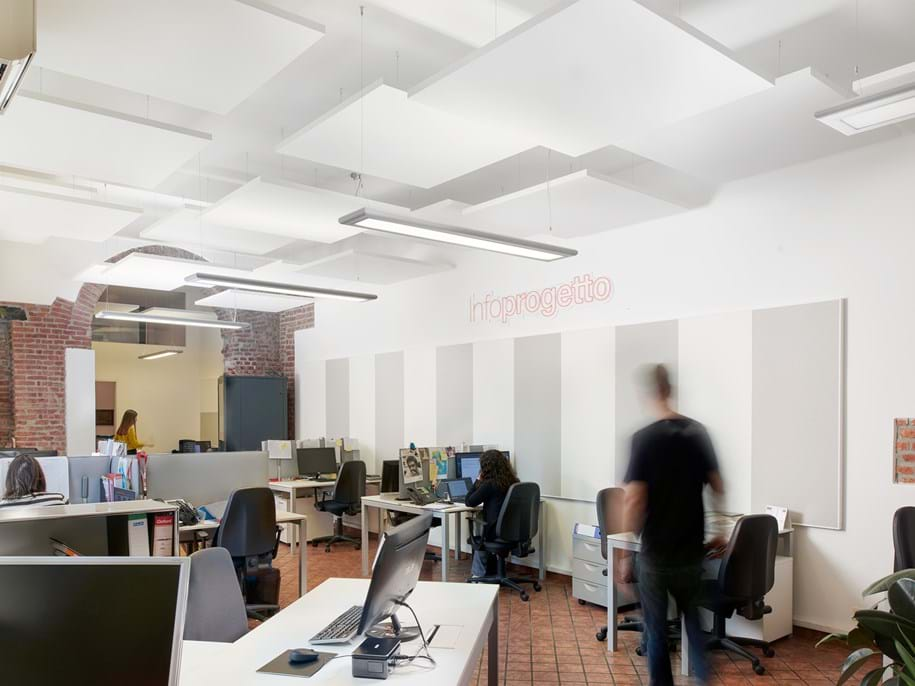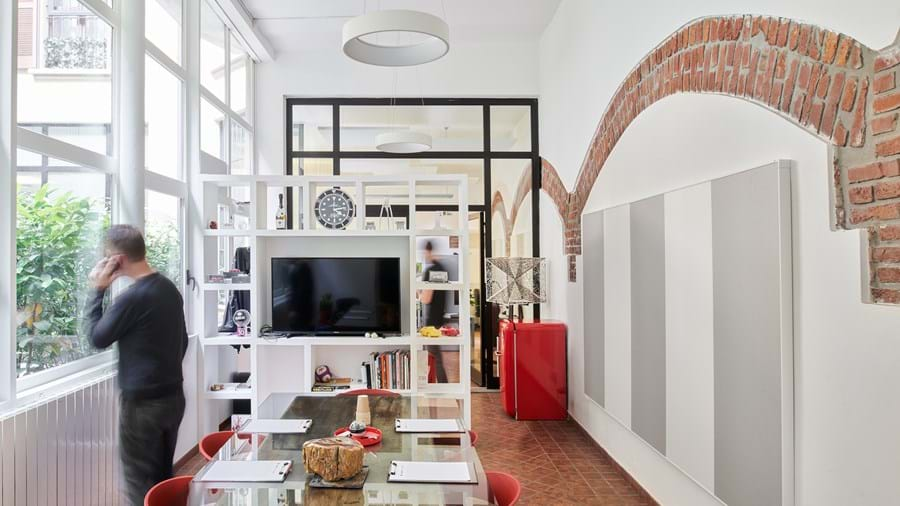
Enhancing workplace experience through acoustic design – A case study in open-plan office
Infoprogetto is a company specialising in providing training, with its office located in a historic building in Milan. Initial internal assessments revealed challenging acoustic conditions that negatively affected employee wellbeing and productivity. Conversations carried throughout the space, background noise caused distractions, and limited speech privacy made it difficult for employees to focus and collaborate effectively.
Recognising the impact of poor acoustics on daily operations, office management partnered with Ecophon in Italy. Together, they implemented a strategic acoustic upgrade, transforming the workspace into a more comfortable, engaging, and productive environment.
Project overview
Located in a central Milan, Infoprogetto’s offices feature a rectangular open-plan layout with an adjacent meeting room. The original design included plastered walls, terracotta flooring, large windows, and a lowered plasterboard ceiling – a combination that contributed to excess reverberation and speech propagation, directly influencing the acoustic experience.


Acoustic renovation: methodology and standards
To enhance sound conditions while preserving the office’s aesthetic appeal, a combination of ceiling-mounted acoustic systems and wall-mounted sound-absorbing panels was introduced. The intervention followed ISO 22955: Acoustic Quality in Open-Plan Offices, ensuring alignment with international best practices for workplace acoustics. This standard provides clear guidelines on room geometry, workspace layout, and the nature of office activities, optimising the balance between collaboration and focus.
Key acoustic parameters considered:
- In-Situ Acoustic Attenuation of Speech (DA,S): Measures how effectively speech levels are reduced between workstations, directly impacting speech privacy.
- Spatial Decay Rate of Speech (D2,S): Evaluates how quickly speech volume decreases with distance – a crucial factor in open-plan settings.
- Reverberation Time (RT): Determines how long sound lingers in the space, affecting noise levels and speech clarity.
Office activities and acoustic challenges
The Infoprogetto offices support a mix of tele-video conferencing, customer service, and sales – activities classified as Type 2 under ISO 22955, which are highly sensitive to noise distractions. Employees frequently engage in calls and discussions, making speech clarity and speech privacy essential for an effective work environment.
Additionally, the Lombard Effect – where people unconsciously raise their voices to compensate for background noise – was a challenge, further amplifying workplace disturbances. The goal of the acoustic intervention was to create a more balanced, focused, and less fatiguing workspace by reducing speech propagation and improving clarity for nearby conversations.
Implemented acoustic solutions
A comprehensive acoustic strategy was implemented, incorporating Ecophon Solo™ Square acoustic rafts and Ecophon Akusto™ Wall C panels. The staggered ceiling arrangement introduced a dynamic visual element while effectively controlling sound reflections. The result? A tailored acoustic experience that enhances concentration, speech privacy, and overall workplace comfort – allowing employees to work more efficiently in a space designed for both communication and focus.

Ecophon Solo™ Square acoustic rafts

Ecophon Akusto™ Wall C panels
Acoustic measurements – key improvements
Recent improvements, assessed in line with ISO 22955, reveal significant enhancements in speech privacy, noise control, and overall acoustic experience.
Quantifiable acoustic improvements:
- Speech Attenuation (DA,S): Increased from 1.9 dB to up to 7.5 dB, significantly improving speech privacy and reducing the spread of conversations.
- Speech Decay (D2,S): Improved by more than 2 dB on average, reaching up to 6 dB. For employees, this means a more natural and distraction-free sound environment – closer to the way sound behaves outdoors.
- Reverberation Time (RT): Reduced from 0.9 seconds to 0.35 seconds, creating a well-balanced acoustic setting that minimises echo and enhances speech clarity.
Real employee experiences – survey insights
Beyond the numbers, what truly matters is how people experience their work environment. To understand the impact of these acoustic treatments, we conducted surveys twice, before and after acoustic intervention, with a 2-month gap. Employees were asked about general noise levels, speech noise, speech privacy, and overall office aesthetics. Using a six-point Likert scale (1 = "very dissatisfied" to 6 = "very satisfied"), participants rated their experience.

Key findings:
Reduction in speech noise disruptions
- This suggests a notable improvement in perceived noise control, reducing distractions from distant conversations.
Improved overall acoustic comfort
- This reflects a significant enhancement in overall acoustic conditions, aligning with a more balanced and controlled sound environment.
Enhanced speech privacy
- This indicates a better sense of separation between workstations, reducing the impact of overheard speech.
Aesthetic satisfaction & perception of space quality
- The acoustic treatment using Ecophon Solo™ and Ecophon Akusto™ Wall contributed not only to sound management but also to the overall perception of office quality.
Business impact and design considerations
This case study highlights the crucial role of acoustic design in modern workplaces. By integrating ISO 22955 guidelines into office planning from the start, architects, designers, and investors can create environments that enhance both productivity and employee wellbeing.
The findings reinforce that effective acoustic treatment isn’t just a technical enhancement – it’s a strategic investment in workplace experience. When done right, it not only reduces noise-related distractions but also elevates the aesthetic appeal of the space.
The result is an enhanced workplace experience where people can feel more comfortable, focused, and engaged.
Case study author: Cristina Carrus
Writer: Magda Szubert